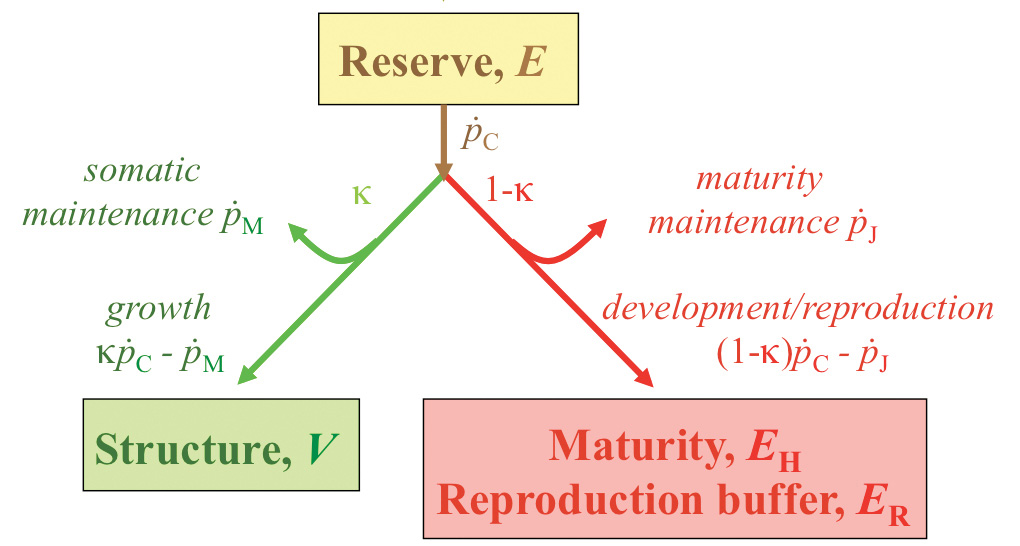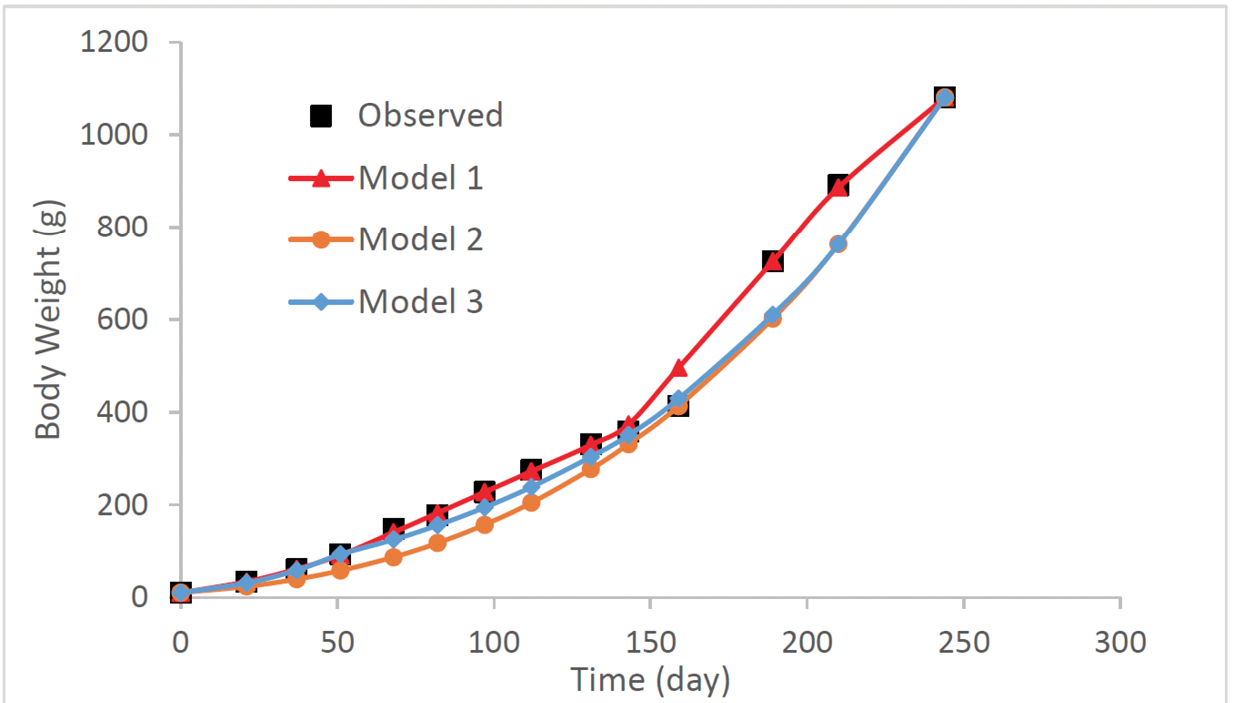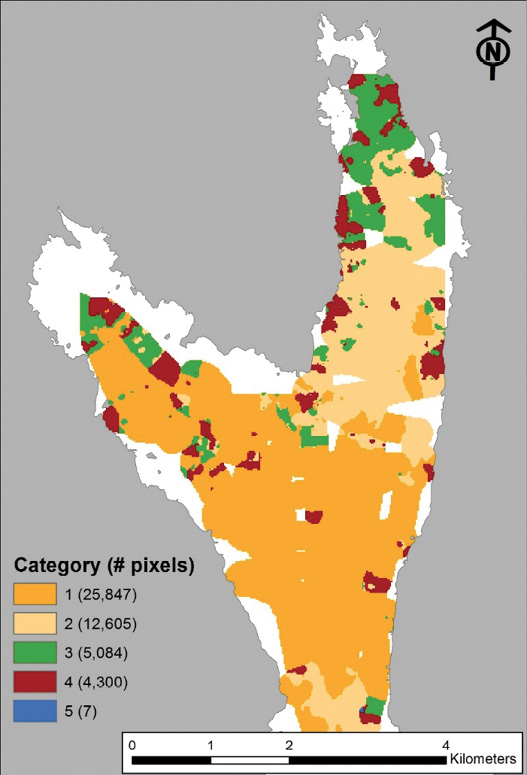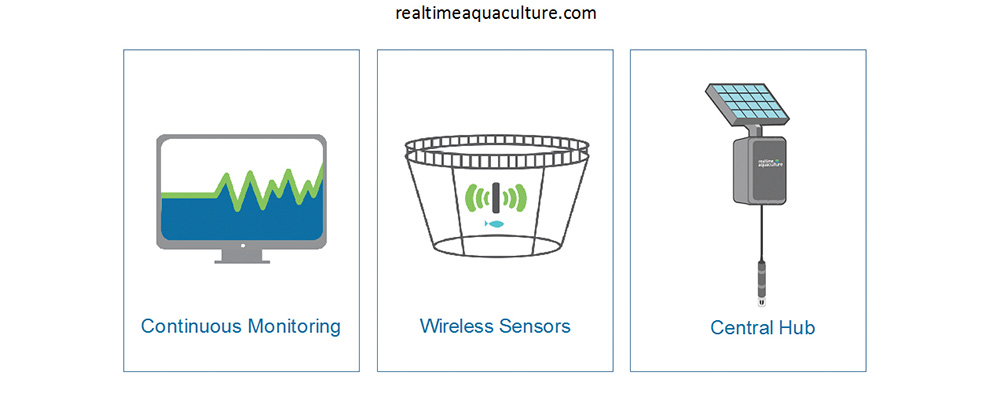Canadian Aquaculture R&D Review 2017
Miscellaneous
Integrating Individual Bioenergetics into Aquaculture Management
Understanding individual bioenergetics is critical for assessing how environmental drivers (e.g., temperature, food availability, oxygen, currents, etc.) affect the performance of cultured species. Dynamic Energy Budget (DEB) has become the most cutting-edge theory on the organization of metabolism of individual organisms. The mechanistic nature of DEB allows its application to the full range of environmental conditions, which is vital to quantify the role of cultured species in ecosystem functioning and predict their responses to anthropogenic changes and/or changes in climate. Despite the individual-based approach of DEB, the most recent ecosystem models rely on DEB theory to simulate individual bioenergetics and extrapolate the results to the ecosystem level.
This research program focuses on individual bioenergetics of cultured species, ranging from Atlantic Salmon to mussels and oysters, as well as invasive tunicates that are relevant to the management of aquaculture sites. State-of-the-art technology, such as acoustic tags and laser particle counters, will be key for the success of the program. In this program we will explore the effects of extrinsic drivers such as diseases, parasites, temperature, and food availability, as well as intrinsic factors such as the internal state of the organism. Moreover, the resulting refined and state-of-the-art individual models will be coupled to larger scale models to contextualize aquaculture at the ecosystem level with the ultimate goal of adopting an ecosystem-based management approach.
This research program will generate fundamental scientific knowledge that will: 1) inform industry on key processes of individual behaviour and bioenergetics; and 2) assist policy makers and managers in dealing with current and future issues such as invasive species and aquaculture management.
Date: MAR. 2016–MAR. 2021
Funded by: Cooke Aquaculture Inc.
Co-funded by: Dalhousie University
Project Lead: Ramón Filgueira (Dalhousie U)
Collaborators: Luc Comeau, Peter Cranford, Thomas Guyondet (DFO); Jon Grant (Dalhousie U); Cooke Aquaculture Inc.; Vemco
Contact: ramon.filgueira@dal.ca
Science-Industry Partnership Leading to a Better Understanding of Ocean Acidification in British Columbia, Canada
The goal of this study is to investigate the spatial and temporal variability of Ocean Acidification (OA) parameters at two sites in the northern Salish Sea; one being a continuous monitoring system at a research station and the other being a partnering local shellfish producer’s farm site. Increased anthropogenic carbon dioxide (CO2) uptake by the surface ocean is driving a reduction in oceanic pH. This acidification alters the carbonate chemistry of the seawater, decreasing the saturation state of carbonate minerals essential to shell- forming organisms. Consequently, OA will have major implications for the shellfish aquaculture industry in the long-term. Currently, key information is lacking for coastal settings, hindering identification of near-term effects. It is critical to monitor coastal areas to determine the current status and plan mitigation strategies for the impact of increasing OA on the shellfish industry.
In this study, weekly OA samples were collected at the farm site and compared them with the high resolution data collected at the research station. Preliminary analyses reveal two important features: 1) OA signals are coherent across both sites, suggesting that they are influenced by similar processes and that broadcast high resolution data available on a public web portal (Global Ocean Acidification Observing Network data portal: http://portal.goa-on.org/Explorer?action=oiw:fixed_platform:HAKAI_Quadra1) is an important diagnostic for the industry partner; and 2) the OA data fluctuated across a large range between sampling events at the farm site indicating the importance of short time scale variability in setting conditions.
The information produced in this study demonstrates the critical importance of science-industry partnerships for filling the extensive OA data gap present in coastal settings. Ultimately the information garnered by studies like this will aid in the development of adaptation strategies for the regional impacts of this significant global problem.
Date: MAY 2016–ONGOING
Funded by: Hakai Institute
Project Lead: Wiley Evans (Hakai Institute)
Project Team: Katie Pocock, Alex Hare (Hakai Institute)
Collaborators: Sawmill Bay Shellfish Co.
Contact: Wiley.Evans@hakai.org
Website: www.hakai.org
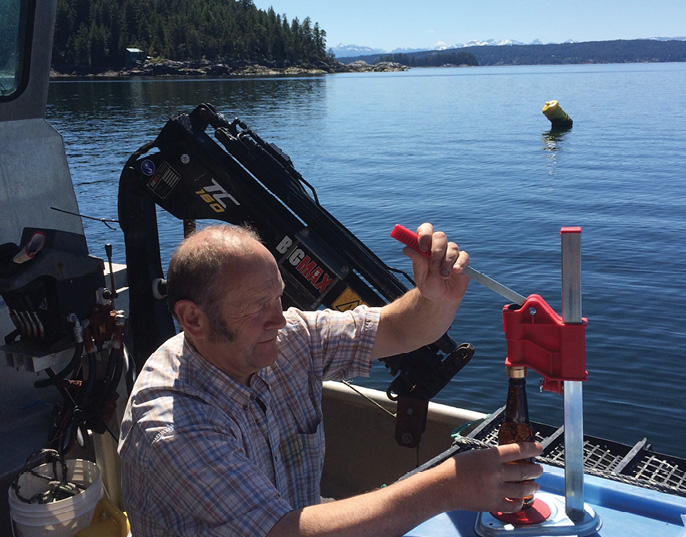
Stephen Pocock (Sawmill Bay Shellfish) collects a discrete seawater sample at his aquaculture site on Read Island, BC. Photo: Wiley Evans (Hakai Institute)
Algae-Based Ingredients for Aquaculture Feeds in Canada
Conventional aquaculture feed resources are becoming increasingly costly and ecologically unsustainable. In an effort to develop more sustainable feeds based on ‘lower-trophic’ ingredients, certain algae have been proposed as promising candidates based on their perceived supply of well-balanced amino acids, essential fatty acids, and bioactive compounds. However, despite this encouraging trend, many of the nutritional claims for aquaculture feeds are unsubstantiated because their required biochemical profiles, digestibility data, and effects on animal performance are either inadequate or non-existent. Take for example Chlorella spp., which is one of the most highly studied microalgae for industrial applications. While these algae have been proposed for large-scale cultivation for bioremediation, renewable energies, health food supplements, and sustainable animal feeds, there has never been an adequate strategic assessment of their nutritional quality as feed ingredients for Atlantic Salmon; the most widely farmed fish in Canada. This is the case for virtually all algal species presently considered for industrial mass algaculture.
At the National Research Council of Canada and in partnership with industry and academia, a major focus is to evaluate the potential for algal products and co-products for use in aquaculture feeds as a means to valorize the algal crop produced as a result of industrial CO2 conversion. To do this, we use a suite of existing and emerging technologies such as, photobioreactor algal cultivation and harvesting, chemical and biochemical profiling, in vitro digestibility, biomass processing and feed production technologies, and in vivo biological performance evaluation with target species.
In addition to valorization of the algal crop resulting from industrial CO2 conversion, we expect that this applied, industrially-relevant research will also help to provide essential nutritional data for national regulatory approval and industry adoption of novel dietary ingredients of algal origin in Canada. To date, we have generated biochemical profiles and digestibility data (in vitro and in vivo) for 13 microalgae species and 9 seaweed species.
Date: SEP. 2013–MAR. 2017
Funded by: NRC–National Bioproducts Program (NBP); NRC–Algal Carbon Conversion (ACC) Program
Project Lead: Sean Tibbetts (NRC)
Project Team: Patrick McGinn, Stephen O’Leary (NRC)
Collaborators: André Dumas (CATC); Daniel Lemos (University of São Paulo); Jason Mann (EWOS; Cargill Canada)
Contact: Sean.Tibbetts@nrc-cnrc.gc.ca
Website: http://www.nrc-cnrc.gc.ca/eng/solutions/collaborative/algal_index.html
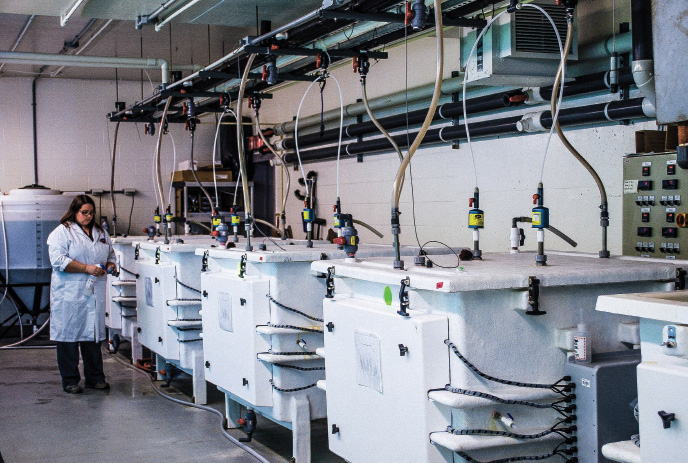
NRC Technical Officer, Jenny MacPherson, poses with NRC-developed “Brite-Box” photobioreactors (>10,000 L production capacity). Photo: Scott MacQuarrie (NRC)

Example of chlorophytic microalgal biomass for nutritional evaluation as a potential novel ingredient for aquaculture feeds. Photo: NRC
Development of a Brown Alga Chorda filum Culture Method
Magdalen Islands mussel farming companies want to diversify their marine lagoon production and are interested in growing macroalgae. Chorda filum, a fast growing brown alga that occurs naturally in the lagoons of the region, could be a good candidate since there are markets for this edible alga. The general purpose of the project was to develop an understanding of the steps involved in growing C. filum, i.e., cultivating gametophytes in vitro, growing sporophytes on ropes, in tanks, and growing sporophytes on a sea farm in lagoons. The project was also designed to establish the nutritional and sensory profile of this alga. Fertile fronds were harvested in September. Two types of lights (white and red) and three temperatures (5, 10, and 15°C) were tested for growing gametophytes. Vegetative growth of in vitro gametophytes appeared to be optimal at 10°C in white light. Two methods were used to grow sporophytes on ropes: by directly seeding the ropes with spores and by spraying gametophytes on kuralon ropes. In both cases, sporophytes were produced by keeping cultures at 10°C in white light and gradually reducing the water temperature to 5°C. In tanks, the average growth of the fronds was 1.3 cm/day and the largest fronds reached 191 cm. Undesirable opportunistic macrophytes such as Ulva sp. were always present in the cultures despite the fact that the fertile fronds of C. filum had been disinfected prior to sporulation.
The project diversified the portfolio of cultivable edible macroalgae species with a summer tubular species distinct from leaf kelp.
Date: SEP. 2014–OCT. 2016
Funded by: Ministère de l’éducation et de l’enseignement supérieur du Québec (MÉES) [Québec Ministry of Higher Education and Training]
Project Lead: Lisandre Gilmore-Solomon (Merinov)
Project Team: Isabelle Gendron-Lemieux, Karine Berger, Éric Tamigneaux (Merinov)
Collaborators: Michel Fournier (Les moules de culture des Îles inc.)
Contact: Isabelle.Gendron-Lemieux@merinov.ca
Website: http://alguequebec.org/ (availabe in French only)

A. Female Chorda filum with a developing sporophyte embryo; B. Young C. filum sporophyte; C. C. filum sporophytes on culture ropes in a tank. Photo: Isabelle Gendron-Lemieux (Merinov)
Assessing the Efficiency of a Macroalgae Biofilter in Regulating Nitrate and Phosphate Concentrations in Tanks at the Montreal Biodome Mimicking the Gulf of St. Lawrence Ecosystem
To improve the quality of recycled water in the exhibition’s tanks housing the Montreal Biodome live collections, it is necessary to search for a complementary method for controlling nitrate and phosphate build-up simultaneously. In excessive concentrations, these nutrients can become an important source of stress for aquatic organisms. Based on integrated multi-trophic aquaculture systems, we wish to design a macroalgae biofilter adapted to absorb nitrates and phosphates under conditions similar to those of the Montreal Biodome’s marine ecosystem.
The performance of native species, Ulva lactuca and Palmaria palmata, were assessed for six days at École des Pêches et de l’Aquaculture du Québec (EPAQ) in Grande-Rivière. The average daily nitrate absorption rate for P. palmata was found to be 0.65 mg∙N∙g MS-1 versus 1.76 mg∙N∙g MS-1 for U. lactuca. The average daily phosphate absorption rates for P. palmata were 0.14 mg∙P∙g MS-1 versus 0.32 mg∙P∙g MS-1 for U. lactuca. Seven to 12% of nitrates and four to 24% of phosphates were removed by P. palmata while U. lactuca removed eight to 18% of nitrates and five to 24% of phosphates.
After the P. palmata culture was introduced at the Montreal Biodome, other trials led to an improvement in biofiltration performance. In addition, the excess biomass is used to fertilize the exhibition tanks.
This research project has improved the water quality of the Montreal Biodome exhibition tanks, and led to the enrichment of exhibition tank by providing natural shelter and food for aquatic animals.
Date: JAN. 2014–APR. 2017
Funded by: MITACS; Société des amis du Biodôme de Montréal (SABM); Natural Sciences and Engineering Research Council of Canada (NSERC)–Industrial Research Chair
Co-Funded by: Fonds d’amorçage UQAR; Mérinov Inc.; Ressources Aquatiques Québec (RAQ)
Project Lead: Nathalie Le François (Montreal Biodome; U Laval)
Project Team: Anne Tremblay-Gratton (U Laval); Grant Vandenberg (U Laval); Éric Tamigneaux (EPAQ)
Contact: nle_francois@ville.montreal.qc.ca
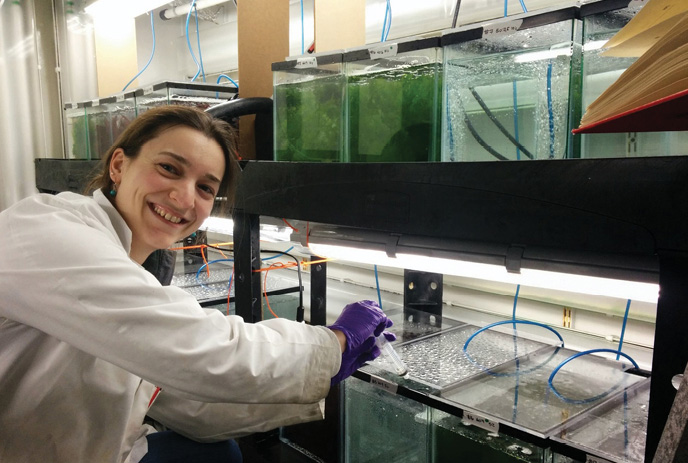
Anne Tremblay-Gratton in plant science room (EPAQ). Photo: Nathalie Le François (Biodome de Montréal)

Seaweed culture aquarium for the master’s project in the plant science room (EPAQ). Photo: Anne Tremblay-Gratton (U Laval)

Ulva lactuca (EPAQ). Photo: Anne Tremblay-Gratton (U Laval)
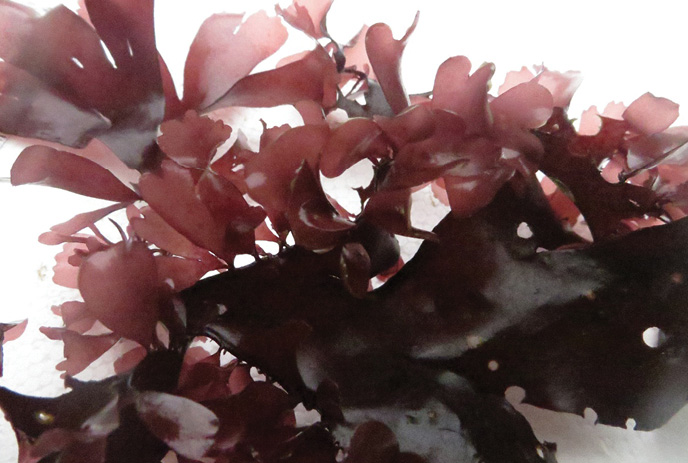
Palmaria palmata. Biodome de Montréal. Photo: Anne Tremblay-Gratton (U Laval)

Palmaria palmata. Biodome de Montréal. Photo: Anne Tremblay-Gratton (U Laval)

Palmaria palmata. Biodome de Montréal. Photo: Anne Tremblay-Gratton (U Laval)

Palmaria palmata. Biodome de Montréal. Photo: Anne Tremblay-Gratton (U Laval)
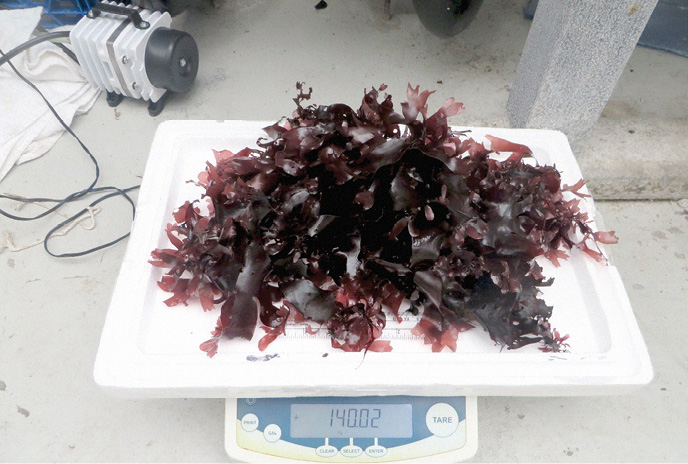
Palmaria palmata. Biodome de Montréal. Photo: Anne Tremblay-Gratton (U Laval)
Biotic and Abiotic Determinants Influencing Winter Flounder Feeding Behaviour and Larval Growth
Winter Flounder (Pseudopleuronectes americanus) is a fish species that occurs off the east coast of North America. This species is of great interest for temperate aquaculture and recreational fishing, which requires seed production in order sustain stocks in coastal habitats. However, development of aquaculture production is limited by high mortalities in the initial benthic phase. Feed quality plays an important role in limiting these mortalities. The purpose of this project is to verify the nutritional quality (in terms of fatty acids) of copepod nauplii as alternative live prey and compare it with traditional aquaculture feed (rotifers). In addition, flounder use shallow habitats where significant human activities occur. Another objective of the project is to assess whether boat noise affects feeding behaviour in this species, particularly during the larval period, while individuals are still pelagic. Such information could assist in the selection of seeding areas.
This study defines the impact of biotic parameters such as prey quality on Winter Flounder larval growth and the impact of anthropogenic noise on this species’ feeding behaviour.
Date: APR. 2015–MAR. 2018
Funded by: Fonds de Recherche du Québec en Nature et Technologies (FRQNT) team research project
Project Lead: Réjean Tremblay (UQAR-ISMER)
Project Team: Gilberte Gendron, Maria Martínez-Silva, Céline Audet, Gesche Winkler (UQAR-ISMER)
Collaborators: Aurélie Jolivet (CNRS Research Unit 6539; TBM environnement); Fréderic Olivier (BOREA Research Unit 7208; CNRS; MNHN; UPMC; IRD)
Contact: Rejean.Tremblay@uqar.ca
Lumpfish and Atlantic Halibut Aquaculture Operations Optimization
Farming Atlantic Halibut (Hippoglossus hippoglossus) and Lumpfish (Cyclopterus lumpus) represents an opportunity for Quebec’s aquaculture industry to diversify its activities and markets with native species that tolerate captivity well. The project aims to improve the survival rate of these two marine fish species.
For Atlantic Halibut, the project focuses on the period between egg incubation and juvenile rearing because proficiency in larval rearing of flatfish is a critical step influencing performance in subsequent stages of the development cycle.
As lumpfish is a new farmed species, the project covers all stages of its life cycle.
A method has been developed to breed Lumpfish. From the first cohort of farmed Lumpfish, Merinov performed breeding trials from the larval stage to sexual maturity. The organization is now producing 3rd generation farmed larvae. Current trials are designed to optimize the various stages of production. The 4th generation should be produced in winter.
Merinov trials have produced halibut eggs and larvae. To date, it has been impossible to maintain larvae beyond metamorphosis. Further trials are scheduled for January 2017.
The project has contributed to the advancement of marine fish culture and the training of highly qualified staff.
Date: JUN. 2014–JUN. 2017
Funded by: Fonds de Recherche du Québec en Nature et Technologies (FRQNT)
Project Lead: Marie-Hélène Fournier (Merinov; CÉGEP de la Gaspésie des et Îles)
Project Team: Tony Grenier (Merinov)
Contact: mhfournier@cegepgim.ca
Website: www.merinov.ca
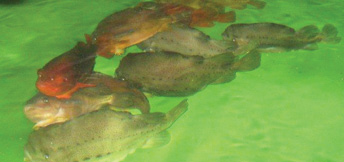
Lumpfish spawners. Photo: Marie-Hélène Fournier (Merinov; CÉGEP de la Gaspésie des et Îles)

A Lumpfish larva. Photo: Marie-Hélène Fournier (Merinov; CÉGEP de la Gaspésie des et Îles)
Physiology of Triploid Fish
Triploidy is the only management tool currently available for ensuring reproductive sterility of farmed fish. Sterile populations can be of direct benefit to industry since sexually mature fish often have reduced flesh quality and disease resistance. Sterility also addresses the risk of escaped fish breeding in the wild. However, triploids are rarely used in aquaculture because of performance limitations. We are investigating the effects of triploidy on key physiological processes to determine whether changes in cell size and number, associated with triploidy, affect the ability of these animals to withstand chronic stress. Our research currently focuses on red blood cell structure and function, aerobic capacity, bioenergetics, and environmental tolerances (high temperature and hypoxia). We have adopted zebrafish as a model species for some of this research because of the availability of stocks with fluorescent cells that are ideal biomarkers for cell location and function. Additional research is being done with Brook Charr, as a model salmonid that is easy to keep in our small-scale aquatic facility at the University of New Brunswick (UNB) campus. Research results will be translated to Atlantic Salmon through industry partnerships.
Understanding the physiological limitations of triploidy will allow for improvements in their culture protocols for commercial production. This will benefit the aquaculture industry in two ways: by eliminating early maturation of production fish and by ensuring that escaped fish cannot breed in the wild.
Date: ONGOING
Funded by: NSERC–Discovery Grants Program
Co-Funded by: New Brunswick Innovation Foundation (NBIF)–Research Assistantships Initiative
Project Lead: Tillmann Benfey (UNB)
Project Team: Chris Small, Nicole Nader, Krista Latimer, Tillmann Benfey (UNB)
Contact: benfey@unb.ca
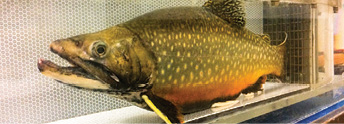
Adult male Brook Charr in a swim flume used for measuring oxygen uptake at various temperatures. Photo: Krista Latimer (UNB)
Antifouling Control: Development of Non-Biocidal Techniques for Mariculture
Increased proliferation of biofouling (amalgam of algae, bivalves, crustaceans, or other invertebrates) on breeding structures and organisms is a major challenge for sea farmers, particularly oyster and scallop farmers. In the Magdalen Islands, this problem is amplified by the proliferation of invasive aquatic species: Golden Star Tunicate (Botryllus schlosseri) and Violet Tunicate (Botrylloides violaceus). This colonization is having a significant economic impact on the industry: additional costs for maintaining and cleaning structures, premature structural degradation, deterioration in the quality of breeding stock organisms, etc.
Current techniques used to attenuate the impact of biofouling are often very inefficient. In response to a growing phenomenon catalyzed by climate change, producers must identify new, more efficient processes, without risk to farmed organisms and consumers. This is why Merinov is working on this project to improve management of mariculture structures and survival of the breeding organisms, oysters, and scallops. The techniques tested are non-biocidal antifouling paints and natural competitors such as Periwinkle (Littorina littorea) and Hermit Crab (Pagurus spp.). Tests are performed in a natural and a controlled environment to compare the anti-fouling effectiveness of these treatments under different conditions.
This project provides an opportunity to test several innovative techniques to stop or reduce the development of biofouling on stock structures. In the long term, these advances will make companies more cost-effective and competitive. They may also provide benefits for other marine industries.
Date: SEP. 2016–MAR. 2017
Funded by: DFO–Partnership Fund
Co-Funded by: Merinov
Project Lead: Madeleine Nadeau (Merinov)
Project Team: Nicolas Toupoint (Merinov)
Collaborators: Nathalie Simard (DFO); Biomer consortium
Contact: Nicolas.Toupoint@merinov.ca
Website: www.merinov.ca

Control structure, no treatment. Photo: Merinov
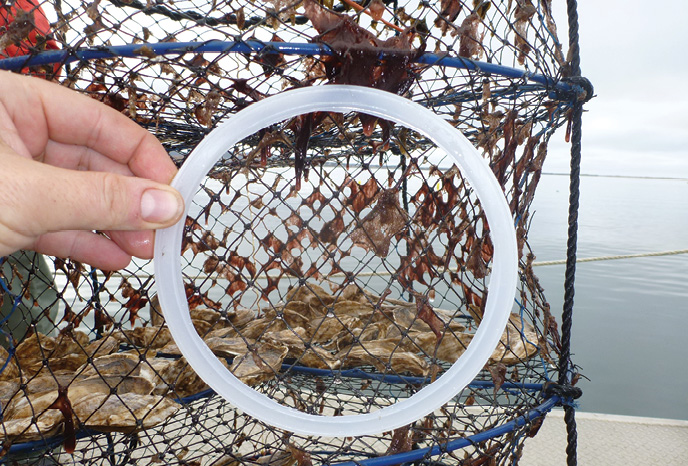
Structure which received an antifouling coating treatment. Photo: Merinov
Engineering Project in Support of the Fishing and Aquaculture Industry
In order to be as efficient as possible and remain competitive, marine aquaculture companies need to meet significant adaptation or technological development needs. Merinov’s engineering team provides various services such as computer-assisted design, 3D modelling, and system and process optimization.
Among one if its many accomplishments, Merinov modified an outdoor mussel spat collector by adding a rotating drum with a hydraulic motor. This change significantly reduced labour costs. A job that once required three employees now requires two.
At a mussel farmer’s request, Merinov also designed a mussel spat collection system for conventional collectors. The collection system was modelled. The mussel stripping system was modified to improve worker ergonomics and reduce physical effort. This work greatly reduces travel time during operations. Mechanizing this work sped up operations and provided a significant increase in performance.
Many other initiatives by the Merinov engineering team have helped marine aquaculture companies in the Gaspé, Magdalen Islands, and North Shore areas optimize their farming methods.
From time to time, Merinov engineering projects also cover some fishing industry needs. For example, a recently developed underwater camera housing is now used to produce images of crab movement near a cage for 20 to 24 hours.
Thanks to the new equipment and technologies installed in company facilities, sea farmers will become more cost-effective.
Date: APR. 2015–MAR. 2017
Funded by: Ministère de l’Agriculture, des Pêcheries et de l’Alimentation du Québec (MAPAQ); Ministère du Développement Économique, de l’Innovation et Exportation du Québec (MDEIE)
Project Lead: Lise Chevarie (Merinov)
Project Team: Lise Chevarie, Daniel Leblanc, Hubert Murray (Merinov)
Collaborators: Private companies
Contact: Lise.Chevarie@merinov.ca
Website: www.merinov.ca
System for mussel sock dismantlement. Video: Merinov
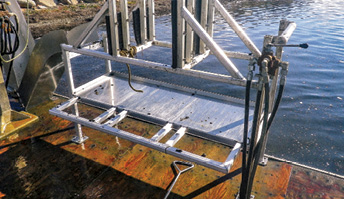
Mussel spat collector. Photo: Daniel Leblanc (Merinov)
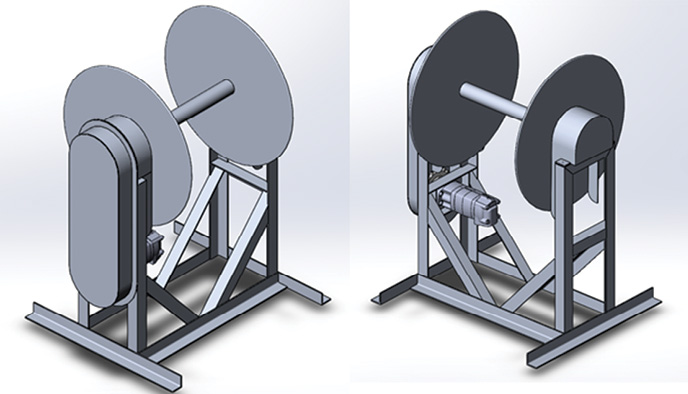
Design drawings of a rotating drum with a hydraulic motor. Photo: Daniel Leblanc (Merinov)
Service Viviers-Conseils: Innovation Service in Support of the Lobster Industry
In recent years, lobster landings have increased. Since the fishing season is open for only about 10 weeks, lobster marketing companies have to process and market large volumes in a very short time. During this time, various issues arise: labour shortages, insufficient storage capacity, reduced ability to obtain better prices from buyers, quality management issues, etc.
Service Viviers-conseils, created by Merinov–Centre collégial de transfert de technologie des pêches du CÉGEP de la Gaspésie et des Îles, is addressing this industry problem by helping companies innovate in order to optimize their systems and containment conditions.
It is necessary to innovate in this field since 60% of Quebec lobster is marketed live. For instance, producers can consult Merinov to diagnose mechanical and biological parameters, set up new tanks, and monitor lobster quality status prior to marketing. In, they also offer support for setting up an automation system, implementing research and development projects, and custom training.
Service Viviers-conseils promotes the marketing of very high quality lobster, several months after the fishing season. It makes companies more productive and competitive by increasing their containment capacity, providing superior product quality, and modernizing their equipment.
Date: APR. 2016–MAR. 2021
Funded by: Natural Sciences and Engineering Research Council of Canada (NSERC)
Co-Funded by: Emploi Québec; Private Sector
Project Lead: Jean-François Laplante (Merinov)
Project Team: Marie-Claude Côté-Laurin, Francis Coulombe, Madeleine Nadeau (Merinov);Marie-Hélène Bénard, Lisandre Solomon-Gilmore (Merinov; Cégep de la Gaspésie et des Îles); Marie-Hélène Fournier (EPAQ); Jacinthe Bourgeois (Cégep de la Gaspésie et des Îles)
Collaborators: Private Sector
Contact: Jean-François.Laplante@merinov.ca
Website: www.merinov.ca
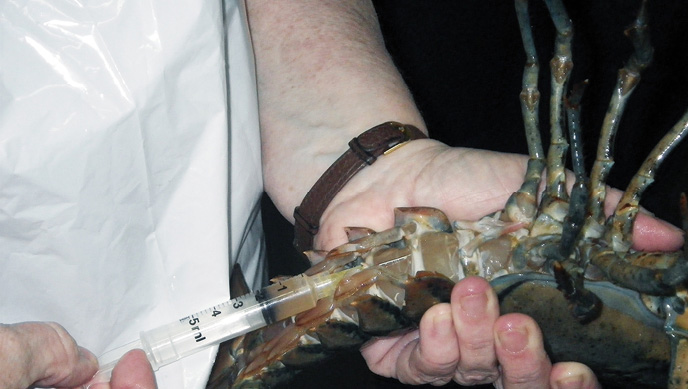
Hemolymph sampling for blood protein analysis to verify lobster quality. Photo: Jean-François Laplante (Merinov)
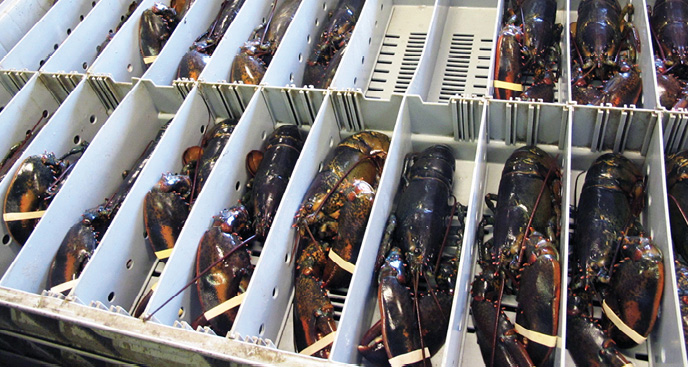
Extended lobster containment. Photo: Jean-François Laplante (Merinov)
Identification of Growth Stanzas and the Modification of the Body Weight Exponent in the Thermal-Unit Growth Coefficient (TGC) Model for Nile Tilapia (Oreochromis niloticus)
The ability to predict growth of aquaculture species has improved with the adoption of the thermal-unit growth coefficient (TGC) model. However, the TGC model does not account for changes in growth patterns across life stages by assuming a constant body weight exponent (b=1/3). The objective of this study is to improve the predicative ability of the TGC growth model through the identification of growth stanzas and modification of the body weight exponent in Nile Tilapia (Oreochromis niloticus).
Growth data were collected from commercial tilapia culture operations (329 observations); growth rates were calculated using the TGC model and regressed against body weights. Three growth stanzas, representing changes in growth patterns across life stages, were identified using spline and broken-line analysis. A non-linear model was applied to growth data and body weight exponents iteratively solved for in each identified growth stanza. Analysis resulted in a modified TGC model with body weight exponents (b) of 0.405, 0.798, and 0.956 in each growth stanza. The modified TGC model (Model 1) was compared to the traditional TGC growth model (Model 2), and the TGC model (b=1/3) modified to include three growth stanzas (Model 3). Goodness-of-fit statistics (R2, CCC, RSS, etc.) and model selection criteria (AIC) determined Model 1 was superior to Model 3; Models 1 & 3 were superior to Model 2. The inclusion of growth stanzas improved the fit of the TGC model, with modification of the body weight exponent further improving the fit, resulted in a more realistic and biologically sound growth model.
Growth functions are integral in farm production management, current growth functions used in aquaculture overlook the potential of difference in growth pattern (stanzas) during the production cycle. The proposed model incorporates growth stanzas, and differing body weight exponents in each growth stanza, in an effort to better represent growth at any given life stage of a fish.
Date: SEP. 2015–ONGOING
Funded by: MITACS Canada
Co-Funded by: Ontario Graduate Scholarship (OGS)
Project Leads: Christopher Powell, Dominique Bureau (U Guelph)
Project Team: James France, Owen Skipper-Horton, Fiona Tansil (U Guelph)
Contact: cpowell@uoguelph.ca, dbureau@uoguelph.ca
The Feasibility of Using Bacterial Community Profiling with Next-Generation DNA Sequencing to Assess Temporal and Spatial Environmental Disturbances
Changes to marine habitats, either from natural or anthropogenic sources, will be reflected in the species diversity and the physiological traits of the organisms. This characteristic profile of species by habitat is reflected at many different size scales ranging from bacteria to large mobile marine animals. The goal of this study is to test the concept that benthic conditions can be easily and cost-effectively monitored via bacterial populations using MiSeq, a rapid DNA sequencing technology that is being adopted internationally and setting new standards for environmental monitoring. We feel that this new technique could be applicable to all bottom types, in all depths of water, and may give an accurate overview of the current benthic oxygen level that drives much of the biodiversity of interest for the management of industrial activities. Because we will be sampling from the surface layers where the turnover of bacteria can be very rapid, the technique will allow us a view of the current environmental conditions of the bottom. We propose to test this concept in the Bay of Fundy to develop an understanding of the spatial and temporal limitations of this technique. Ultimately, we envision this as a broad-based tool that can be used across the country, in both marine and freshwater habitats, and on all bottom types. It is designed to mesh well with other techniques being developed in separate research initiatives, both nationally and internationally.
We are entering a new era in biology where genetic technologies are allowing us insights, which were not available previously, into biological processes and characteristics of animals and the habitats they inhabit. If successful, this project will add another tool for scientists and managers to assess impacts of various practices and potentially a mechanism to provide baseline information for longer term climate change impacts to the ecosystem.
Date: JUN. 2016–MAR. 2017
Funded by: DFO–Program for Aquaculture Regulatory Research (DFO–PARR)
Project Lead: Shawn Robinson (DFO)
Project Team: Helen Gurney-Smith, Jonathan Day, Steve Neil, Craig Smith (DFO)
Collaborators: Ben Forward (RPC)
Contact: Shawn.Robinson@dfo-mpo.gc.ca
Website: www.dfo-mpo.gc.ca/aquaculture/rp-pr/parr-prra/projects-projets/2016-M-10-eng.html
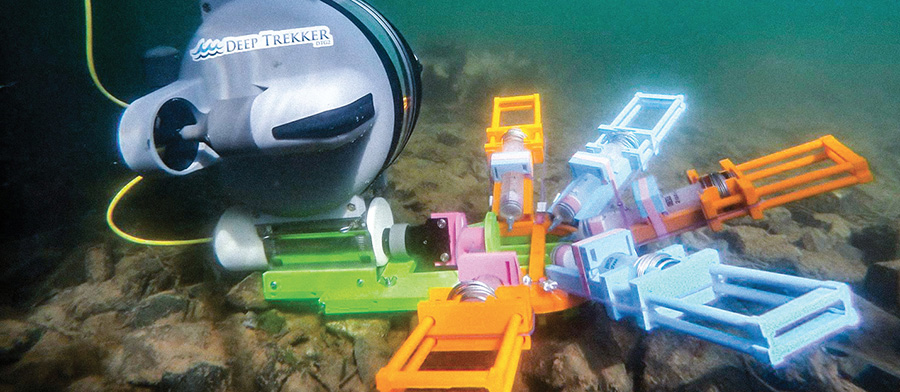
Remotely operated vehicle (ROV) and bacterial syringe sampler taking a surface sediment sample on a rocky bottom in the Bay of Fundy. Photo: Shawn Robinson (DFO)
Metagenomic Approach to the Characterization of Microflora in Aquaculture Effluents that Induce Phytoprotection and Growth Promotion of Aquaponic and Hydroponic Plants
Environmental protection concerns are growing in the agri-food sector, particularly in the aquaculture industry, where effluent capture and recovery have become priorities. At the same time, the hydroponics sector is seeking more sustainable nutrient sources and biological methods for fighting specific pathogens. Aquaponics technology can be used in this context to produce vegetable plants from fish excrement, which microorganisms convert into digestible nutrients. In return, the plants clean the water by catching elements that are toxic to fish, so that 99% of the water can be recycled. Aquaculture effluents promote the growth and performance of a wide range of hydroponic plants. We recently demonstrated that the microflora present in aquaculture effluents induces phytoprotection against Pythium ultimum and Fusarium oxysporum, two significant pathogens in agriculture. However, there is little information providing a taxonomic description of this specific microflora. This research project will identify, through metagenomic methods, microorganisms promoting plant growth and phytoprotection in hydroponics and aquaponics. This will allow the development of a better understanding of their interactions with plants and the impact they have on them. The characterization of a hydroponic system’s unique microflora will allow for the identification of beneficial species, and foster their development and marketing as phytopathogenic biocontrol agents or even organic fertilizers.
Date: APR. 2015–MAR. 2018
Funded by: Ministère de l’Agriculture, des Pêcheries et de l’Alimentation du Québec (MAPAQ)
Project Lead: Grant Vandenberg (U Laval)
Project Team: Benjamin Laramée, Nicolas Derome, (U Laval); Martine Dorais (AAC)
Collaborators: Youbin Zheng (U Guelph)
Contact: Grant.Vandenberg@fsaa.ulaval.ca
Website: http://www.vrrc.ulaval.ca/fileadmin/ulaval_ca/Images/recherche/bd/chercheur/fiche/424160.html

Benjamin Laramée in front of his aquaponic system. Photo: Benjamin Laramée (U Laval)
NSERC-Cooke Industrial Research Chair in Sustainable Aquaculture
Farming of fish and shellfish in the ocean is equal in importance to harvest fisheries as a means of seafood production. Concerns about disease and waste management as well as interaction with commercial fisheries have led to controversy among the industry, government regulators, and coastal communities. There are, however, many avenues of environmental improvement feasible for ocean culture of salmon in net pens. Cooke Aquaculture, the largest locally owned aquaculture company in North America, has partnered with Dalhousie University, in a research program on aquaculture sustainability. Professor Jon Grant is the NSERC-Cooke Industrial Research Chair in Sustainable Aquaculture.
An approach involving simulation modelling is being employed using computer models and mapping of aquaculture ecosystems to predict the transport of diseases and waste particles by ocean currents. A field program of oceanographic instruments and sampling at coastal sites, including Cooke Aquaculture farm operations, is being used to check the reliability of the predictions. Various planning scenarios are explored with this method, which can be used to arrange farm sites to minimize the spread of disease or accumulation of waste. Dalhousie’s inclusion of training of highly qualified personnel in the research program furthers this cooperation with the aquaculture industry in a new chapter in the practice of environmentally conscious fish farming.
This research into the sustainability of salmon farming includes an ecosystem approach to aquaculture and marine spatial planning.
Date: JAN. 2014–DEC. 2018
Funded by: Natural Sciences and Engineering Research Council (NSERC)–Industrial Research Chairs Grants
Co-Funded by: Cooke Aquaculture Inc.
Project Lead: Jon Grant (Dalhousie U)
Project Team: Ramon Filgueira (Dalhousie U)
Collaborators: Tom Taylor (Cooke Aquaculture Inc.)
Contact: jon.grant@dal.ca
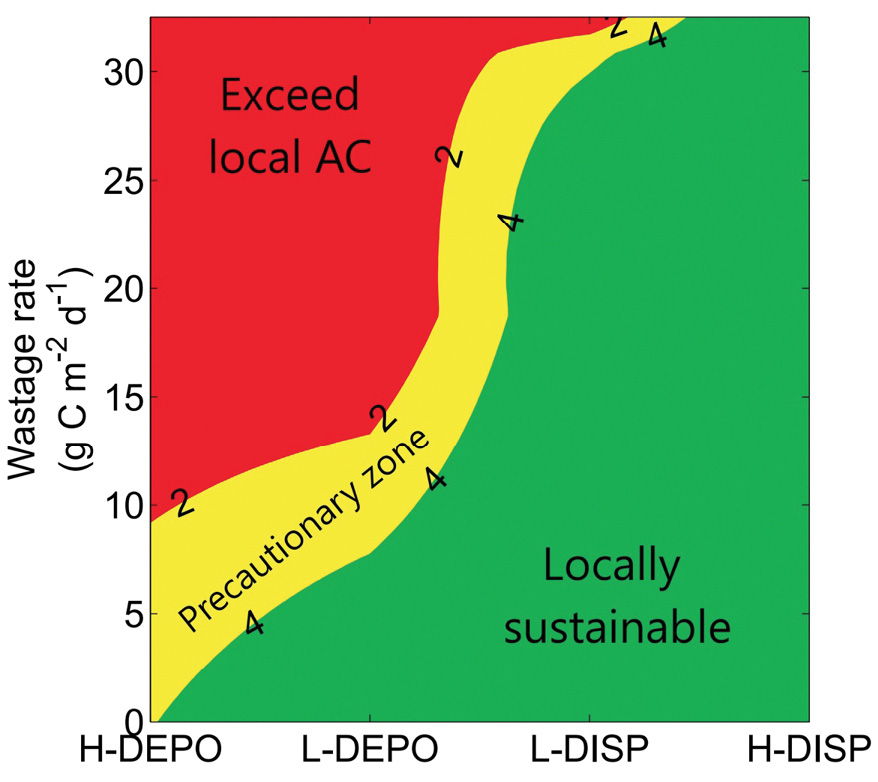
Simulation of benthic process allows estimation of assimilative capacity (AC) of sediments near aquaculture sites. Sediment oxygen is contoured as a function of waste deposition (fish feed and pellets) relative to hydrodynamic regime from highly depositional to highly dispersive. Red regions are low sediment oxygen due to high deposition and low dispersion.

Drone used for mapping salmon habitat in Upper Salmon River, Fundy National Park. Photo: Jon Grant (Dalhousie U)
Evaluation of Different Biomasses for a Pilot Project to Breed Fly Larvae, an Alternative Source of Protein and Lipids in Animal Feed
In Quebec, the management of organic waste recycling, aimed at reducing landfill use, is currently challenging. There is also a critical need for alternative cost-effective and environmentally-friendly ingredients for livestock feed. Fish meal derived from the overexploitation of marine ecosystems is not sustainable, and the volumes produced cannot keep up with the growing demand from the aquaculture industry.
Our approach combines the two issues, using fly larvae to recycle organic waste into quality feed that is high in protein and other nutrients. Fly larvae production is simple, low-cost, and environmentally friendly.
The goal of this project in the first year is to evaluate various ratios of feed substrates produced from fruit and vegetable waste and microbrewery grains on the growth and nutritional composition of two species of fly larvae (i.e., Black Soldier and Domestic Fly). The second year will focus on incorporating marine waste to assess its impacts on larval omega-3 content to enhance the nutritional quality of fish meal for carnivorous species. Larval meal and oil production costs will also be assessed to determine whether they meet the constraints of aquaculture feed producers.
This project will thereby validate the success of establishing fly larva production to recycle organic waste and make it fit for inclusion in fish feed for aquaculture species in Canada.
Date: MAY 2015–DEC. 2017
Funded by: Ministère de l’Agriculture, des Pêcheries et de l’Alimentation du Québec (MAPAQ); Mitacs
Project Lead: Grant Vandenberg (U Laval)
Project Team: Justine Richard-Giroux, Marie-Hélène Deschamps (U Laval); Marie-Pier Aubin, Charles Lavigne (CDBQ)
Contact: Grant.Vandenberg@fsaa.ulaval.ca
Website: http://www.vrrc.ulaval.ca/fileadmin/ulaval_ca/Images/recherche/bd/chercheur/fiche/424160.html

Legend: Adult Black Soldier Flies mating. Photo: Justine Richard-Giroux (U Laval)
The Development of an FVCOM Hydrodynamic Model to Support Aquaculture on the West Coast of Vancouver Island
Previous hydrodynamic modelling in the Broughton Archipelago and the Discovery Islands has demonstrated the advantage of having a computer (numerical) model that provides accurate three dimensional information on current flow, temperature, and salinity. FVCOM (Finite Volume Coastal Ocean Model), when fully developed for this area, promises to provide accurate 3D information. Since FVCOM’s development process is complex, this research project is using existing information and new data collected specifically for this project in order to further develop the model.
The ultimate goal of the project is to be able to apply the accurate FVCOM 3D information to examine particle tracking, virus dispersion, and sea lice behaviour in the waters off the West Coast of Vancouver Island in and around aquaculture sites in the area.
The results of this project (the developed model) will be important for the sustainable management of the aquaculture industry. The data will inform mitigation actions that can be recommended by management bodies in response to well characterized risk. From an industry perspective, these results can inform best management practices in order to offset possible impacts.
Date: MAY 2015–JUN. 2017
Funded by: DFO–Aquaculture Collaborative Research and Development Program (DFO–ACRDP)
Co-Funded by: Cermaq Canada Ltd.; Grieg Seafood BC Ltd.
Project Lead: Peter Chandler (DFO)
Project Team: Mike Foreman, Darren Tuele, John Morrison, Pramod Thupaki, Di Wan, Ming Guo, Maxin Krassovski (DFO)
Collaborators: Kathleen Frisch (Cermaq Canada Ltd.); Barry Milligan (Grieg Seafood BC Ltd.)
Contact: Peter.Chandler@dfo-mpo.gc.ca
Website: www.dfo-mpo.gc.ca/aquaculture/rp-pr/acrdp-pcrda/projects-projets/15-1-P-03-eng.html
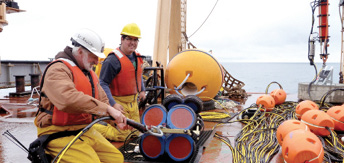
Final checks prior to the deployment of a current meter mooring from the CCGS John P. Tully off the west coast of Vancouver Island are made by Lucius Perreault and Roger Savoie. Data collected by a network of moorings are used to validate the currents simulated by the FVCOM hydrodynamic model. Photo: David Spear (DFO)
Fish Farm Site-to-Site Connectivity Using GPS Tracked Surface Drifters and FVCOM-Based Particle Tracking Model
Aquaculture Bay Management Areas (ABMAs) were implemented in southwest New Brunswick in 2006 as part of a multi-faceted effort to manage disease within fish farms and reduce the potential for the spread of disease between farms and geographic areas. The boundaries of the ABMAs were chosen so that the estimated exchange of water and associated water borne pathogens between ABMAs on a tidal time scale (~12.5 h) was minimized. Although the ABMA approach to disease management seems to have been successful, the original ABMA structure imposed some limitations that have operational and socio-economic consequences. Splitting some of the ABMAs will increase the total number of ABMAs in the southwest New Brunswick area and may increase water exchange between the new ABMAs but it could help provide more operational flexibility to the industry. This approach could also offer more socio-economic stability to the residents of the area by providing more consistent and stable employment. This is particularly relevant to the island of Grand Manan in the mouth of the Bay of Fundy where employees sometimes need to travel by ferry to and from work on the island because of the lack of a third ABMA. Both industry and provincial government desire a better understanding of the potential for water exchange between the farm sites within the existing ABMAs and the risk potential for disease-spread between fish farms prior to decision making. A more advanced water circulation model, Finite Volume Coastal Ocean Model (FVCOM), new particle tracking models, and new current meter data from the offshore area of Eastern Grand Manan will soon be available. When these data are combined with the new drifter data collected under this project, a more substantial examination of the potential for water exchange between the fish farms in the ABMAs will be possible.
Date: APR. 2016–JUN. 2019
Funded by: DFO–Aquaculture Collaborative Research and Development Program (DFO–ACRDP)
Co-Funded by: Atlantic Canada Fish Farmers Association (ACFFA)
Project Lead: Fred Page (DFO)
Project Team: Susan Haigh, Sean Corrigan, Sarah Scouten, Frederick (Jack) Fife (DFO); Mike Beattie, Pat Mowatt (DAAF); Betty House (ACFFA)
Collaborators: Sue Farquharson (ACFFA)
Contact: Fred.Page@dfo-mpo.gc.ca
Website: www.dfo-mpo.gc.ca/aquaculture/rp-pr/acrdp-pcrda/projects-projets/16-1-M-03-eng.html
Contribution to the Identification of a Locally Available Food Source for Sustainable Tilapia (Oreochromis niloticus) Production in the Democratic Republic of Congo
Tilapia farming is one alternative that can contribute to reducing food insecurity in the Democratic Republic of Congo and in Africa as a whole, as this fish species is highly productive and adapts better to low inputs in fish farming. However, the use of optimized feed with a high content of fish meal is not encouraged, given their high costs and their very limited availability to farmers. Identifying locally available resources would make it possible to develop fish farming and reduce production costs. This study involved evaluating the effects that substituting fish meal with vegetable protein sources would have on zootechnical and nutritional performances (e.g., growth, food use), as well as the cost of fish production. Tests were conducted on juvenile tilapia (Oreochromis niloticus) (~ 15-20 g) at the aquatic sciences lab at Université Laval. Three diets were tested: 1) Rcongo: the main substitution test food made with African ingredients; 2) Rcanada: the second test food made with the same ingredients but acquired in Canada; and 3) Rcommercial: a commercial control feed made with fish meal. Although the commercial feed had a higher zootechnical performances compared to the Rcongo test feed, the cost-benefit analysis indicated that it was more economically advantageous because it reduced fish production costs by 36% compared to commercial feed.
The project allowed the reduction of fish production costs through the informed use of vegetable protein sources and a food source that is easily accessible by farmers.
Date: JUN. 2015–AUG. 2015
Funded by: Fonds Forestier pour le Bassin du Congo (FFBC); African Development Bank (AfDB)
Co-Funded by: Programme Élargi de Formation en Gestion des Ressources Naturelles dans le Bassin du Congo (PEFOGRN-BC)
Project Lead: Grant Vandenberg (U Laval)
Project Team: Albert Tshinyama, Emilie Proulx, Marie-Hélène Deschamps, Damase Khasa (U Laval); Freddy Okitayela (University of Kinshasa)
Collaborators: Mélodie Richard, Corina Nagy (U Laval)
Contact: Grant.Vandenberg@fsaa.ulaval.ca
Website: http://www.vrrc.ulaval.ca/fileadmin/ulaval_ca/Images/recherche/bd/chercheur/fiche/424160.html
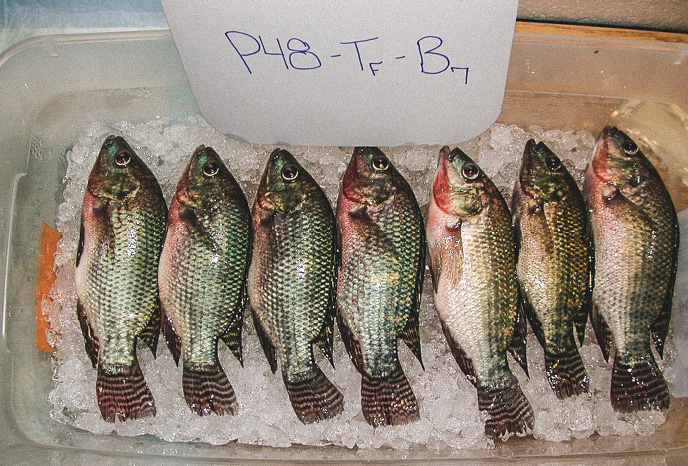
Final sampling of tilapia (O. niloticus) on day 28. Photo: Albert Tshinyama (U Laval)

Collection of feces by syphoning for tilapia digestibility study. Photo: Albert Tshinyama (U Laval)
Benthic Culture of Sea Cucumbers: Assessing Interactions Between Cultured and Wild Populations and the Mitigation of Environmental Impacts in Shellfish Co-Culture
High market demand has resulted in a great deal of interest in culturing the California Sea Cucumber (Parastichopus californicus) in British Columbia (BC). However, before these operations can proceed to full scale production, additional base-line data are needed to determine the viability and potential impacts of culturing sea cucumbers. The primary aims of this project are to determine: 1) the growth and survival of sea cucumbers in benthic culture; 2) the environmental impact of sea cucumber aquaculture; and 3) the potential interactions between wild and benthic-ranched individuals. The results of this project show promise for the development of sea cucumber aquaculture in BC. Juveniles have shown good growth and survival when raised in benthic cages both on and away from an existing deep-water oyster farm. When co-cultured with oysters, the nutrient rich benthic habitat at these sites may allow for higher growth rates and stocking densities. High densities of sea cucumbers often found at existing aquaculture sites may help to ameliorate some of the nutrient loading and associated environmental impacts of shellfish aquaculture. However, seasonal changes in sea cucumber density at our study site suggest that if preventing mixing of wild and cultured stocks is desired, some form of containment may be necessary.
Expanding our knowledge of benthic ranching techniques for P. californicus and addressing issues such as containment of this species will be mutually beneficial to resource managers and industry partners.
Date: APR. 2012–MAR. 2015
Funded by: DFO–Aquaculture Collaborative Research and Development Program (DFO–ACRDP)
Co-Funded by: Fan Seafoods Ltd.; Klahoose First Nation; Pacific Sea Cucumbers Harvesters Association; Viking Bay Ventures
Project Lead: Chris Pearce (DFO)
Project Team: Dan Curtis, Nick Duprey, Claudia Hand (DFO); Scott McKinley (UBC)
Collaborators: Fan Seafoods Ltd.; Klahoose First Nation; Pacific Sea Cucumbers Harvesters Association; Viking Bay Ventures
Contact: Chris.Pearce@dfo-mpo.gc.ca
Website: www.dfo-mpo.gc.ca/aquaculture/rp-pr/acrdp-pcrda/projects-projets/P-14-02-003-eng.html

Juvenile California Sea Cucumber, Parastichopus californicus, perched on an oyster clump amid a forest of oyster culture strings. Photo: Dan Curtis (DFO)
Optimization of Fly Co-Product Processing Methods for Repurposing Organic Waste in Quebec
The production of insects from organic waste is a sustainable approach that would allow the production of alternative proteins and lipids meeting the needs of animal production. The goal of this project is to improve the techniques for culling Black Soldier Fly larvae, as well as fish meal processing processes, to optimize the nutritional value, safety, and digestibility of fish and chicken feed.
Black Soldier Fly larvae will be produced at the Centre de développement bioalimentaire du Québec (CDBQ), and various culling techniques (i.e., CO2 anaesthesia, by oxygen deprivation and/or freezing) will be tested. The larvae will then be transferred to Université Laval where various packaging techniques will be tested (i.e., pasteurization and Ultra-high temperature processing (UHT) or High pressure homogenization (HPH)) aimed at reducing/controlling the microbial load of the larvae. HPH optimization will facilitate the extraction techniques of co-products such as protein, lipid, and chitin from fly larvae meal. Costs, performance, and product quality, such as lipid and amino acid profiles, will be rigorously monitored at each stage of processing to determine the optimal processes to be retained. Finally, two protein meals obtained through the optimal techniques will be incorporated into experimental diets, and their digestibility and palatability compared to control diets during nutritional testing in fish and chickens.
This project will include the development of insect products meeting nutritional needs of Canadian farmed fish as well as the Canadian safety and hygiene criteria of alternative feeds.
Date: JUN. 2016–MAY 2019
Funded by: Ministère de l’Agriculture, des Pêcheries et de l’Alimentation du Québec (MAPAQ)
Project Lead: Grant Vandenberg (U Laval)
Project Team: Marie-Hélène Deschamps, Jennifer Larouche, Justine Richard, Linda Saucier, Cristina Ratti, Alain Doyen, Lucie Beaulieu, Marie-Pierre Létourneau Montminy (U Laval); Marie-Pier Aubin, Charles Lavigne (CBDQ)
Contact: Grant.Vandenberg@fsaa.ulaval.ca
Website: http://www.vrrc.ulaval.ca/fileadmin/ulaval_ca/Images/recherche/bd/chercheur/fiche/424160.html
Comparative Genomics of the Salmonid Brook Charr for Identifying Physiological/Expression QTL and Conserved Gene Regulatory Networks
In addition to their ecological, cultural and commercial importance, salmonids are of great interest for genetics research and evolutionary biology due to their evolutionary success and the occurrence of an ancestral whole-genome duplication at the base of the lineage. Much research has been conducted in salmonid genetics, and there exist high-density genetic maps for at least eight species, chromosome-level genome assemblies for two species, and many transcriptome studies. However, most of this work has been conducted on two genera, Salmo and Oncorhynchus. The Brook Charr (Salvelinus fontinalis) is of great importance commercially (both from an aquaculture and an angling perspective) but remains much less characterized. This project aims to improve the genetic tools and characterization of Brook Charr.
First, we developed a high-density genetic map with 3826 single nucleotide polymorphism (SNP) markers and a new bioinformatics method to compare the map to all other published high-density salmonid maps, as well as to a non- duplicated outgroup, to identify chromosome correspondence among the species. Second, we identified quantitative trait loci (QTL) associated with growth, reproductive and stress-resistance traits. We also identified the sex chromosome and confirmed striking recombination rate differences between the sexes. Third, we will use RNA-sequencing to perform expression QTL (eQTL) analysis and characterize gene expression networks and central hub genes. Finally, we will anchor assembled genomic scaffolds on the newly developed genetic map and compare with other species. Collectively, this work will identify regions of the genome important for ecologically and evolutionary important traits, and bring Brook Charr genetics into the genomic era.
This work will develop genomic tools for Brook Charr, including a high-density genetic map, a draft genome assembly, and growth and stress-resistance markers to be used for selective breeding. Additionally, this work will put Brook Charr genomics into the context of the broader study of evolution post whole genome duplication, specifically in terms of sex determination, important genomic regions, and gene expression regulation.
Date: SEP. 2013–SEP. 2017
Funded by: Fonds de recherche du Québec–Nature et Technologies (FRQNT)–Projets de recherché en équipe
Co-Funded by: Société de recherche et de développement en aquaculture continentale Inc. (SORDAC)
Project Lead: Louis Bernatchez (U Laval); Céline Audet (UQAR)
Project Team: Ben Sutherland (U Laval)
Contact: Louis.Bernatchez@bio.ulaval.ca; Celine_Audet@uqar.ca
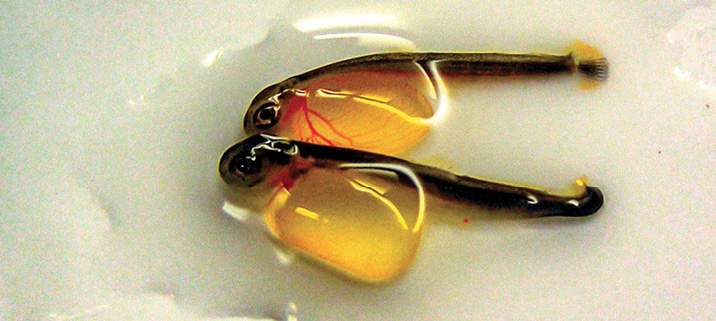
Brook Charr alevins. Photo: Céline Audet (UQAR)
Establishing Zones for Managing Risks Related to Pathogens and/or Pollutants Originating on Finfish Aquaculture Facilities in the Broughton Archipelago and Discovery Islands
Fish farming in coastal waters characterized by strong and variable currents makes understanding the water circulation important to sustain a healthy environment, both on and away from the farm. When many farms share a common environment, the cumulative impacts may be surprisingly complex, especially in an environment that changes daily (tides and winds), seasonally (snowmelt and river runoff), and yearly (climate change). A high precision model (FVCOM) that can represent temperature, salinity, and water flow in three dimensions has been developed. The results of the model simulations (April to October 2010) are stored as 3D data fields at hourly intervals for 21 depth levels, at each of the 36,000 nodes that comprise the model grid. Particle tracking models use the modelled currents to determine the area of influence due to the release of virtual particles from fish farm locations. A field program using surface drifters designed at DFO has been used to validate the model results with observed surface currents. Tracked by a GPS (global positioning system), the drifters provided weeks of positional information to compare with corresponding circulation and particle tracking model simulations. The hydrodynamic connectivity between fish farms in regions such as the Broughton Archipelago and Discovery Islands has been used to contribute to decisions involving pathogen transfer among fish farms, and from fish farms to wild fish. Management zones can then be established based on these criteria.
Date: APR. 2011–APR. 2016
Funded by: DFO–Program for Aquaculture Regulatory Research (DFO–PARR)
Project Lead: Peter Chandler (DFO)
Project Team: Mike Foreman, Diane Masson, Kyle Garver, Dario Stucchi, Darren Tuele, Michael Ikonomou, Stewart Johnson, Marc Trudel (DFO)
Contact: Peter.Chandler@dfo-mpo.gc.ca
Website: www.dfo-mpo.gc.ca/aquaculture/rp-pr/parr-prra/projects-projets/2011-P-08-eng.html
Development of Environmental DNA (eDNA)-Based Biosurveillance for Aquatic Invasive Species (AIS) to Inform Management and Policy Decision-Making Associated with Shellfish Aquaculture Movements
Shellfish movements associated with aquaculture activities are a known vector for aquatic invasive species (AIS) introduction and spread. For example, the transfer of harvested shellfish has been established as a vector for the spread of invasive tunicates, bryozoans, and European Green Crab. Even with mitigation measures like rinsing in place, which is currently used for Green Crab areas, some degree of risk of translocating invasive species is intrinsic to all shellfish movements. As such, informed decision-making around shellfish movements is an important management activity to mitigate risk of new invasions in geographic areas in BC that currently lack AIS that are present at other locations. Along the coast of British Columbia, collecting spatial data on AIS distributions is challenged by high variability in the geographic distribution of AIS at relatively small spatial scales. These patchy AIS distributions also create a challenge for management because it is not feasible to manage shellfish movements in BC at the level of individual AIS or individual bays.
DNA metabarcoding of complex (i.e., mixed-species or environmental DNA) samples generates millions of sequence reads from the majority of species present within the sample simultaneously and with high sensitivity. Using reference DNA sequence libraries, metabarcoding reads can be translated into biodiversity data with a relatively high level of taxonomic resolution and can be used for detection of cryptic, rare, and small taxa, including AIS. The main objective of this project is to transfer into DFO an eDNA-based metabarcoding tool developed by the Canadian Aquatic Invasive Species Network (CAISN) and perform optimization and field-validation for its use as an AIS biosurveillance tool to aid decision-making, including around shellfish aquaculture movements in BC.
Date: APR. 2016–MAR. 2019
Funded by: DFO–Program for Aquaculture Regulatory Research (DFO–PARR)
Project Lead: Cathryn Abbott (DFO)
Project Team: Kristen Marie Westfall, Tom Therriault, Kristi Miller-Saunders, Kara Aschenbrenner, Geoff Lowe, Scott Gilmore (DFO); Melania Cristescu (McGill U); Guang Zhang (McGill U; DFO)
Contact: Cathryn.Abbott@dfo-mpo.gc.ca
Website: www.dfo-mpo.gc.ca/aquaculture/rp-pr/parr-prra/projects-projets/2016-P-03-eng.html
Assimilation Capacity of Organic Matter from Salmon Aquaculture (acom): Improving Model Predictions of Benthic Impacts
The spatial scale, magnitude and persistence of benthic, or seabed, effects from the release of organic wastes are influenced by a range of factors that control waste deposition, recycling, and transport. Previous research has shown that a relationship exists between the deposition rate of organic matter from salmon net-pens and benthic community effects. However, this simple cause-effect relationship neglects to consider many important physical, chemical, and biological processes that are responsible for the manifestation of benthic effects. An important, but poorly understood factor is the inherent capacity of different benthic habitats to mineralize (recycle) this material without significantly altering the natural state of the seabed. This organic enrichment threshold is commonly referred to as the “assimilative capacity”. Ongoing multidisciplinary research in Canada and Norway aims to increase scientific expertise and knowledge on the major processes that determine benthic assimilative capacity under a range of environmental settings and seabed types (mud, sand, and mixed substrate). This work includes studies on waste deposition and dispersion dynamics, the decay rates of organic matter, and oxygen exchanges with the seabed. A separate objective of this research is the development of a model that will provide increased accuracy in predicting the spatial scale and the magnitude of benthic community effects from ocean-based finfish farms.
Date: APR. 2014–MAR. 2017
Funded by: DFO–Program for Aquaculture Regulatory Research (DFO–PARR)
Project Lead: Peter Cranford (DFO)
Project Team: Brent Law, Fred Page, Terri Sutherland, Shawn Robinson, Herb Vandermeulen, Susan Haigh (DFO)
Collaborators: Raymond Bannister (Institute of Marine Research, Norway)
Contact: Peter.Cranford@dfo-mpo.gc.ca
Website: www.dfo-mpo.gc.ca/aquaculture/rp-pr/parr-prra/projects-projets/2014-M-06-eng.html
Evaluation of Genetic Structuring of California Sea Cucumber (Parastichopus californicus) Across Transfer Zones in British Columbia
Fisheries and Oceans Canada (DFO) regulates the introduction and transfer of fish and shellfish into and between facilities in British Columbia so as not to adversely affect local aquatic species and habitats. Requests for introductions and transfers to and from aquaculture facilities are risk-assessed for possible disease, ecological and and genetic effects on native species and ecosystems, and to ensure the regulations are met. There may be a requirement for mitigation measures to minimize any risks associated with transfer activities (e.g., egg disinfection, quarantine of stock).
In British Columbia, five distinct shellfish transfer zones (STZs) span the Pacific Region. STZs are used to manage the movement of cultured shellfish to prevent gene flow between farmed and wild populations, and to manage the transfer of potential parasites/pathogens. Introducing or translocating cultured individuals can lead to gene flow with wild populations, and can result in a loss of genetic variation or adaptive genes found in the wild populations. Therefore, understanding the spatial scales at which shellfish populations are genetically distinct can help to optimize the boundaries of STZs to meet both ecological and socio-economic objectives.
Currently, an Introductions and Transfers Licence is required for both between and within zone transfer activities of sea cucumbers in British Columbia. This study will assess the genetic structure of the California Sea Cucumber (Parastichopus californicus) and compare the location of genetic discontinuities with current STZ boundaries. Information on their genetic structure will also contribute important spatial information for informing fisheries management and the design of Marine Protected Area (MPA) networks. The results of this project will contribute to science advice that can be used to enhance the scientific basic for STZs and the sustainable management of the shellfish aquaculture industry.
Date: APR. 2015–MAR. 2017
Funded by: DFO–Program for Aquaculture Regulatory Research (DFO–PARR)
Project Lead: Janelle Curtis (DFO)
Project Team: Nicholas Duprey, Chris Pearce, Dan Curtis (DFO)
Collaborators: Marie-Josée Fortin, Amanda Xuereb (U of T); Louis Bernatchez (U Laval)
Contact: Janelle.Curtis@dfo-mpo.gc.ca
Website: www.dfo-mpo.gc.ca/aquaculture/rp-pr/parr-prra/projects-projets/2015-P-03-eng.html
- Date modified:
